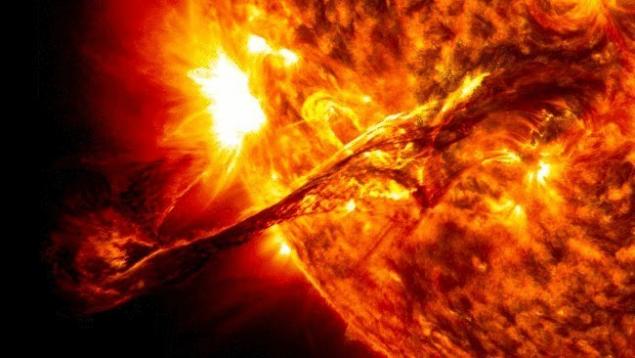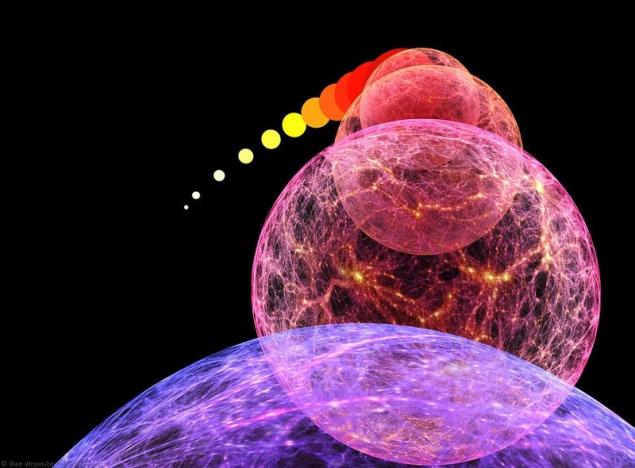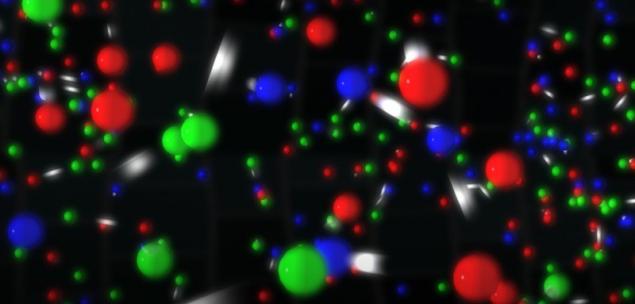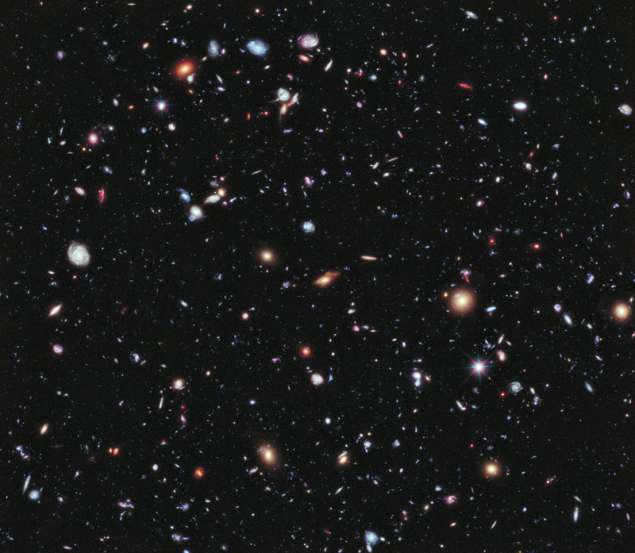Is there a temperature limit?
 Bashny.Net
Bashny.Net
If you would remove all the energy from something, you will reach absolute zero, the lowest temperature in the Universe (well, almost absolute zero, the more the better). But what is the highest temperature? "Nothing is lost. All transformered", said Michael ende. I think many people wondered about the highest possible temperature and found no answer. If there is an absolute zero, there must be absolute... what?

Take the classic experiment: put food coloring in water with different temperatures. What will we see? The higher the water temperature, the faster the food coloring is distributed throughout the volume of water.
Why is this happening? Because the temperature of the molecules is directly connected with kinetic movement and speed of particles involved. This means that in hot water the individual water molecules are moving with greater speed, and this means that the particles of food coloring will be transported faster in hot water than in cold. If you stopped all this movement brought everything to a perfect state of rest (even overcome the laws of quantum physics for the sake of it) — then you would have reached absolute zero: the coldest possible to the thermodynamic temperature.

But what about movement in the other direction? If you heat up a particle system, obviously they will move faster and faster. But is there a limit to how much you can heat it if there's some catastrophe that will prevent you heat them beyond a certain limit?
At a temperature of thousands of degrees of heat that you transfer the molecules will begin to destroy the very ties that hold molecules together, and if you continue to increase the temperature, electrons start to separate from the atom itself. You will receive ionized plasma consisting of electrons and atomic nuclei, in which no neutral atoms at all.
It is still within reason: we have individual particles — electrons and positive ions that will jump at high temperatures, obeying the usual laws of physics. You can raise the temperature and continue to wait.

With further increase in temperature separate entities who are known to you under the "particles" start to break. At about 8 billion degrees (8 x 10^9), you will begin to spontaneously produce pairs of matter-antimatter — electrons and positrons — from raw energy particle collisions.
At 20 billions of degrees, atomic nuclei will start to spontaneously break into separate protons and neutrons.
At 2 trillion degrees, protons and neutrons cease to exist, and will be the fundamental particles, their component quarks and gluons, their relationship at such high energies is not maintained.

At about 2 quadrillion degrees you will start to produce all known particles and antiparticles in large quantities. But this is not the upper limit. Within these limits there are many interesting things. You see, this is the energy at which you can produce the Higgs boson, and therefore the energy at which you can restore one of the fundamental symmetries in the Universe: symmetry, which gives the particle rest mass.
In other words, as soon as you heat the system up to this energy limit, you will find that all your particles are now massless and fly at the speed of light. What was for you a mixture of matter, antimatter and radiation, will become a net radiation (acting like a she), while being matter, antimatter or neither the one nor the other.
And the end is not yet. You can heat the system up to even higher temperatures, though faster to move everything in it will not, it will be filled with energy, just as are light, radio waves, microwaves, visible light and x-rays (and moving at the speed of light), even if you have a completely different energy.
Perhaps born yet unknown particles or manifest new laws (or symmetry) of nature. You might think that it is sufficient to heat and heat to all infinite energy, to know it, but there it was. There are three reasons why this is impossible.

1. In the whole observable Universe has only a finite amount of energy. Take everything that exists in our space-time: all the matter, antimatter, radiation, neutrinos, dark matter and even the energy inherent to space. There are about 10^80 particles of normal matter, of the order of 10^89 neutrinos and antineutrinos, slightly more photons, plus all the energy of dark matter and dark energy spread in a radius of 46 billion light years the observable Universe, the center of which is our position.
But even if you turned it all into pure energy (by E = mc^2), and even if you used all that energy to heat your system, you would not have received an infinite amount of energy. If you enclose it all in a single system, you will receive a huge amount of energy approximately equal to the temperature of 10^103 degrees, but that's not infinity. It turns out, the upper limit remains. But before you get there, you will have another obstacle.

2. If you surround too large an amount of energy in any limited region of space, you will create a black hole. You usually think of black holes as huge, massive, dense objects that are able to swallow a Horde of planets: not bothered, casually, easily.
The fact is that if you attach a separate quantum particle enough energy — even if it is a massless particle moving at the speed of light — it will turn into a black hole. There is a scale on which just to have something with a certain amount of energy will mean that particles will not interact normally, and if you get particles with such energies is equivalent to 22 micrograms, according to the formula E = mc^2, you will be able to gather the energy of 10^19 GeV, before your system will refuse to become hot. You will begin to appear black holes that would instantly decay to a state of low-energy thermal radiation. It turns out, this energy limit is the Planck limit is the top for the Universe and corresponds to the temperature of 10^32 Kelvin.
This is much lower than the previous limit, because not only the universe itself is finite, but black holes are a limiting factor. However, this is not all: there is a limit and forest.

3. At a certain high temperature you release the potential that led our Universe to cosmic inflation, expansion. In the days of the Big Bang, the universe was in a state of exponential expansion when the space expanded, as the space balloon, only exponentially. All particles, antiparticles and radiation quickly separated from other quantum particles of matter and energy, and when inflation ended, it was the Big Bang.
If you manage to reach the temperatures necessary to return the status of inflation, you press the reset button of the Universe and cause inflation, then the Big Bang and so on, all over again. If you have not yet reached, note: if you get to this temperature and will cause the desired effect, you will not survive. Theoretically, this may occur at temperatures of the order 10^28 and 10^29 Kelvin, this is only a theory.
So, you can easily gain a very high temperature. Although the physical phenomena to which you are accustomed, will differ in detail, you will still be able to dial the temperature higher and higher, but only to a point, after which everything you hold dear will be destroyed. But don't be afraid of the Large hadron Collider. Even the most powerful particle accelerator on Earth, we reach energies 100 billion times lower than necessary for the universal Apocalypse.published
P. S. And remember, just changing your mind — together we change the world! ©
Source: hi-news.ru

Take the classic experiment: put food coloring in water with different temperatures. What will we see? The higher the water temperature, the faster the food coloring is distributed throughout the volume of water.
Why is this happening? Because the temperature of the molecules is directly connected with kinetic movement and speed of particles involved. This means that in hot water the individual water molecules are moving with greater speed, and this means that the particles of food coloring will be transported faster in hot water than in cold. If you stopped all this movement brought everything to a perfect state of rest (even overcome the laws of quantum physics for the sake of it) — then you would have reached absolute zero: the coldest possible to the thermodynamic temperature.

But what about movement in the other direction? If you heat up a particle system, obviously they will move faster and faster. But is there a limit to how much you can heat it if there's some catastrophe that will prevent you heat them beyond a certain limit?
At a temperature of thousands of degrees of heat that you transfer the molecules will begin to destroy the very ties that hold molecules together, and if you continue to increase the temperature, electrons start to separate from the atom itself. You will receive ionized plasma consisting of electrons and atomic nuclei, in which no neutral atoms at all.
It is still within reason: we have individual particles — electrons and positive ions that will jump at high temperatures, obeying the usual laws of physics. You can raise the temperature and continue to wait.

With further increase in temperature separate entities who are known to you under the "particles" start to break. At about 8 billion degrees (8 x 10^9), you will begin to spontaneously produce pairs of matter-antimatter — electrons and positrons — from raw energy particle collisions.
At 20 billions of degrees, atomic nuclei will start to spontaneously break into separate protons and neutrons.
At 2 trillion degrees, protons and neutrons cease to exist, and will be the fundamental particles, their component quarks and gluons, their relationship at such high energies is not maintained.

At about 2 quadrillion degrees you will start to produce all known particles and antiparticles in large quantities. But this is not the upper limit. Within these limits there are many interesting things. You see, this is the energy at which you can produce the Higgs boson, and therefore the energy at which you can restore one of the fundamental symmetries in the Universe: symmetry, which gives the particle rest mass.
In other words, as soon as you heat the system up to this energy limit, you will find that all your particles are now massless and fly at the speed of light. What was for you a mixture of matter, antimatter and radiation, will become a net radiation (acting like a she), while being matter, antimatter or neither the one nor the other.
And the end is not yet. You can heat the system up to even higher temperatures, though faster to move everything in it will not, it will be filled with energy, just as are light, radio waves, microwaves, visible light and x-rays (and moving at the speed of light), even if you have a completely different energy.
Perhaps born yet unknown particles or manifest new laws (or symmetry) of nature. You might think that it is sufficient to heat and heat to all infinite energy, to know it, but there it was. There are three reasons why this is impossible.

1. In the whole observable Universe has only a finite amount of energy. Take everything that exists in our space-time: all the matter, antimatter, radiation, neutrinos, dark matter and even the energy inherent to space. There are about 10^80 particles of normal matter, of the order of 10^89 neutrinos and antineutrinos, slightly more photons, plus all the energy of dark matter and dark energy spread in a radius of 46 billion light years the observable Universe, the center of which is our position.
But even if you turned it all into pure energy (by E = mc^2), and even if you used all that energy to heat your system, you would not have received an infinite amount of energy. If you enclose it all in a single system, you will receive a huge amount of energy approximately equal to the temperature of 10^103 degrees, but that's not infinity. It turns out, the upper limit remains. But before you get there, you will have another obstacle.

2. If you surround too large an amount of energy in any limited region of space, you will create a black hole. You usually think of black holes as huge, massive, dense objects that are able to swallow a Horde of planets: not bothered, casually, easily.
The fact is that if you attach a separate quantum particle enough energy — even if it is a massless particle moving at the speed of light — it will turn into a black hole. There is a scale on which just to have something with a certain amount of energy will mean that particles will not interact normally, and if you get particles with such energies is equivalent to 22 micrograms, according to the formula E = mc^2, you will be able to gather the energy of 10^19 GeV, before your system will refuse to become hot. You will begin to appear black holes that would instantly decay to a state of low-energy thermal radiation. It turns out, this energy limit is the Planck limit is the top for the Universe and corresponds to the temperature of 10^32 Kelvin.
This is much lower than the previous limit, because not only the universe itself is finite, but black holes are a limiting factor. However, this is not all: there is a limit and forest.

3. At a certain high temperature you release the potential that led our Universe to cosmic inflation, expansion. In the days of the Big Bang, the universe was in a state of exponential expansion when the space expanded, as the space balloon, only exponentially. All particles, antiparticles and radiation quickly separated from other quantum particles of matter and energy, and when inflation ended, it was the Big Bang.
If you manage to reach the temperatures necessary to return the status of inflation, you press the reset button of the Universe and cause inflation, then the Big Bang and so on, all over again. If you have not yet reached, note: if you get to this temperature and will cause the desired effect, you will not survive. Theoretically, this may occur at temperatures of the order 10^28 and 10^29 Kelvin, this is only a theory.
So, you can easily gain a very high temperature. Although the physical phenomena to which you are accustomed, will differ in detail, you will still be able to dial the temperature higher and higher, but only to a point, after which everything you hold dear will be destroyed. But don't be afraid of the Large hadron Collider. Even the most powerful particle accelerator on Earth, we reach energies 100 billion times lower than necessary for the universal Apocalypse.published
P. S. And remember, just changing your mind — together we change the world! ©
Source: hi-news.ru
Tags
See also
How things work: Advertising photographer
Photograph
Three energy women or what made silent
The revolution of the 21st century! Invented paper ... again
How statins harm the health of your brain
Roger Penrose: the picture of the world on a sheet of paper
Why physicists can't stand the information paradox of black holes?
















